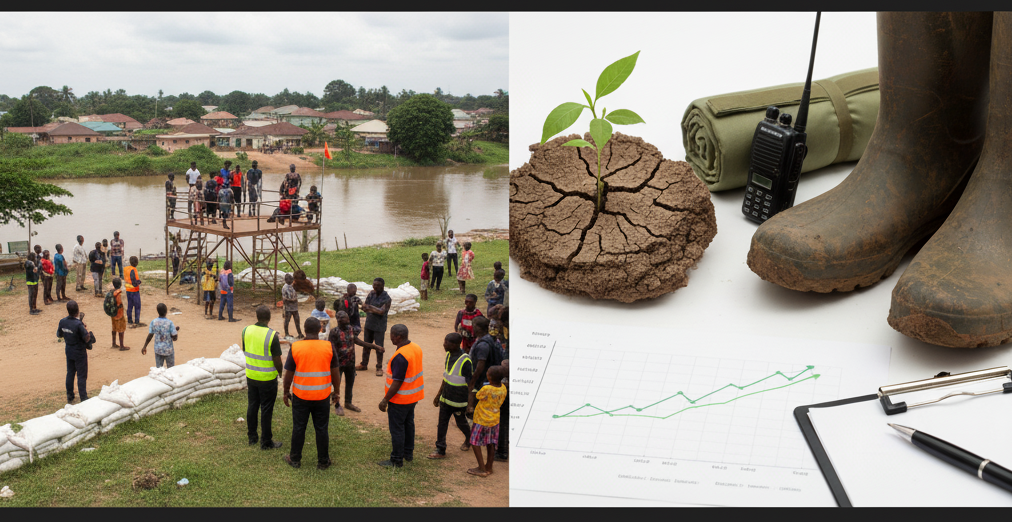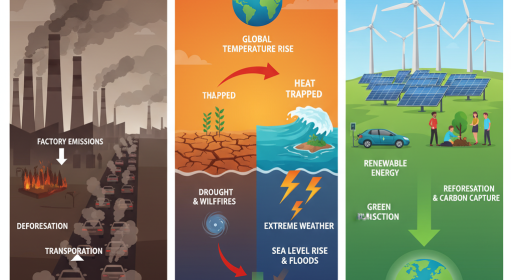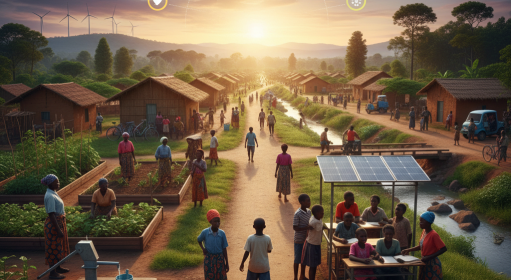When disasters strike, whether devastating floods or industrial spills, the impact on Nigerian communities can be catastrophic. Climate change in Nigeria. Disaster preparedness in Nigeria. Yet, effective preparation, rapid response, and sustained recovery efforts can greatly reduce the loss of life and suffering. Learn how Nigeria is strengthening disaster preparedness through environment and climate change education, risk reduction, and community resilience.
Environment and Disaster Management: Building Preparedness
Disaster resilience hinges on preparedness; cultivating awareness, readiness, and community cohesion before crises occur. Across Nigeria, efforts are underway to instill a culture of readiness. Key initiatives include public education, local volunteer networks, smarter infrastructure, and household planning:
- Public Education & Engagement: The National Emergency Management Agency (NEMA) runs grassroots awareness campaigns to teach people about disaster risks and early warnings. Emergency messages are translated into local languages and broadcast via radio, sometimes even through town criers in rural areas. For example, in Jos, community workshops trained residents on proper waste disposal to prevent clogged drains, a major factor in urban flooding.
- Community Mobilization: Many states have formed Local Emergency Committees made up of trained volunteers with designated shelters on standby. These volunteers organize drills like evacuation exercises in high-risk areas so that when alarms sound, neighborhoods know how to act. Such community-led preparedness was credited with saving lives in flood-prone areas where practice drills have been held.
- Infrastructure & Ecosystem Management: Proactive measures are taken to mitigate disaster impacts. City authorities clear drainage channels before the rainy season (though often this happens reactively once flooding begins). There’s growing recognition of nature-based solutions as well – for instance, replanting mangroves along coastlines to restore natural flood barriers. However, large-scale “climate-proofing” infrastructure projects (e.g. elevating roads, enlarging culverts, reinforcing dams) remain underfunded and slow to materialize. This funding gap means many communities still rely on aging or inadequate infrastructure that may fail under extreme weather.
- Household Preparedness: Families are encouraged to prepare personal emergency plans and “go-bags” – kits one can grab during an evacuation. A go-bag typically includes clean water, non-perishable food, a first aid kit and essential medicines, copies of important documents, a flashlight, and contact information for local emergency services. Communities are mapping out safe evacuation routes and high-ground assembly points, ensuring that everyone (especially children, the elderly, and people with disabilities) knows where to go if they must leave home in a hurry. Such simple steps can save precious time when every second counts.
“Preparedness is more than planning; it’s building a culture of vigilance and mutual help. When government agencies, communities, and civil society partner together, Nigeria stands much better equipped to weather the next disaster. In essence, effective preparedness means problems addressed before they escalate, clearing that blocked gutter today might prevent a neighborhood from flooding tomorrow.“
Nigeria’s Disaster Response in Action

Rapid, coordinated response in the first hours of a disaster saves lives. Disaster risk reduction in Nigeria. Emergency preparedness. Nigeria’s emergency response system kicks into gear as soon as floods, fires, or spills are reported, though the effectiveness can vary by region. Explore how Nigeria responds to disasters (floods, oil spills, and climate risks) through emergency coordination, search and rescue, and relief systems.
- Emergency Coordination: NEMA immediately activates its national and state Emergency Operations Centers as a command hub. Responders from various agencies – SEMA (State Emergency Management Agency), the military, police, Nigerian Red Cross, and NGOs – converge to plan and share duties. This unified Incident Command System helps avoid duplication and fill critical gaps. In practice, that means relief agencies quickly divvy up tasks like search and rescue, medical aid, and logistics, and work to resolve bottlenecks (such as fuel or transport shortages) in real-time. This level of coordination was seen recently when floods hit parts of Niger State; NEMA and SEMA led daily briefings to direct resources efficiently.
- Search & Rescue: Within hours, specialized teams deploy to save those in peril. In flood situations, military and Red Cross boats navigate submerged streets to reach stranded families, while helicopters survey isolated villages cut off by water. Grassroots volunteers also leap into action. For instance, during the May 2025 floods in Mokwa (Niger State), youth-led groups didn’t wait for orders; they grabbed canoes and makeshift rafts to help neighbors trapped on rooftops as the waters rose. Such community heroes, alongside official rescuers, pulled dozens to safety amidst the chaos.
- Evacuations & Shelter: As soon as it’s clear an area is unsafe, authorities work to evacuate residents to higher ground. Schools, churches, and community halls often double as emergency shelters. During the Mokwa flood response, for example, thousands of residents took refuge in a local primary school and a stadium. Relief supplies (food, water, mats, and blankets) were delivered to these shelters within the first day. However, the sudden influx of people meant conditions became extremely cramped. In some shelters, toilets overflowed and there wasn’t enough drinking water or bedding to go around, leading to overcrowding and sanitation issues. Local officials acknowledged these problems and appealed for more support to improve the shelter conditions.
- Health & Relief Delivery: Disasters can quickly turn into public health emergencies. Teams from the Ministry of Health, Nigerian Red Cross, and international partners like UNICEF and WHO work to prevent disease outbreaks and tend to the injured. In flood zones, one urgent priority is providing clean water and sanitation to ward off cholera and other waterborne diseases. (After the Mokwa flooding, there were alerts about cholera risk due to contaminated water.) Mobile clinics and ambulances are deployed to treat injuries or sickness on-site. Simultaneously, relief distribution begins: NEMA coordinates convoys of trucks carrying food, bottled water, mosquito nets, and medicines into affected communities. Yet, delivering aid can be hampered by the very disaster itself, collapsed bridges and flooded roads often block access, slowing the supply chain when it’s needed most. Such logistical challenges mean some survivors might wait days for help, especially in remote or hard-hit locations.
- Communication: Throughout the response, keeping the public informed is vital. Radio broadcasts, SMS alerts, and social media updates (increasingly used by NEMA) share evacuation instructions, safety tips, and where to find assistance. Accurate information helps dispel rumors and directs people toward life-saving resources.
“Nigeria’s emergency response system is evolving with each event, becoming more organized and resourceful. However, gaps remain in logistics, equitable aid distribution, and provision of long-term care. The early hours of a disaster are the most critical, speed and teamwork in this window can literally draw the line between life and death. Every successful rescue and efficient shelter operation in those first few days is a testament to preparation paying off, even as responders continue to learn hard lessons from each new crisis.“




